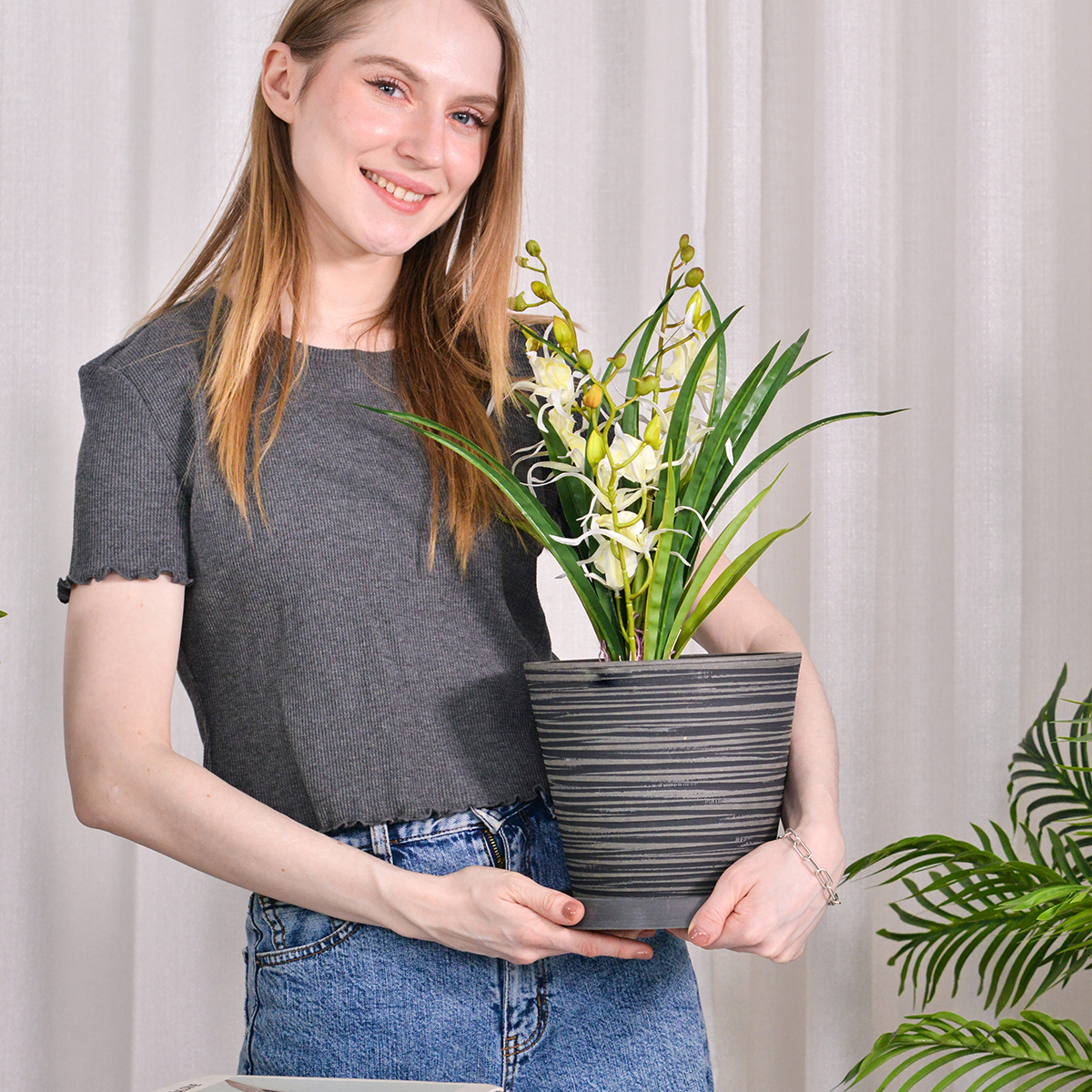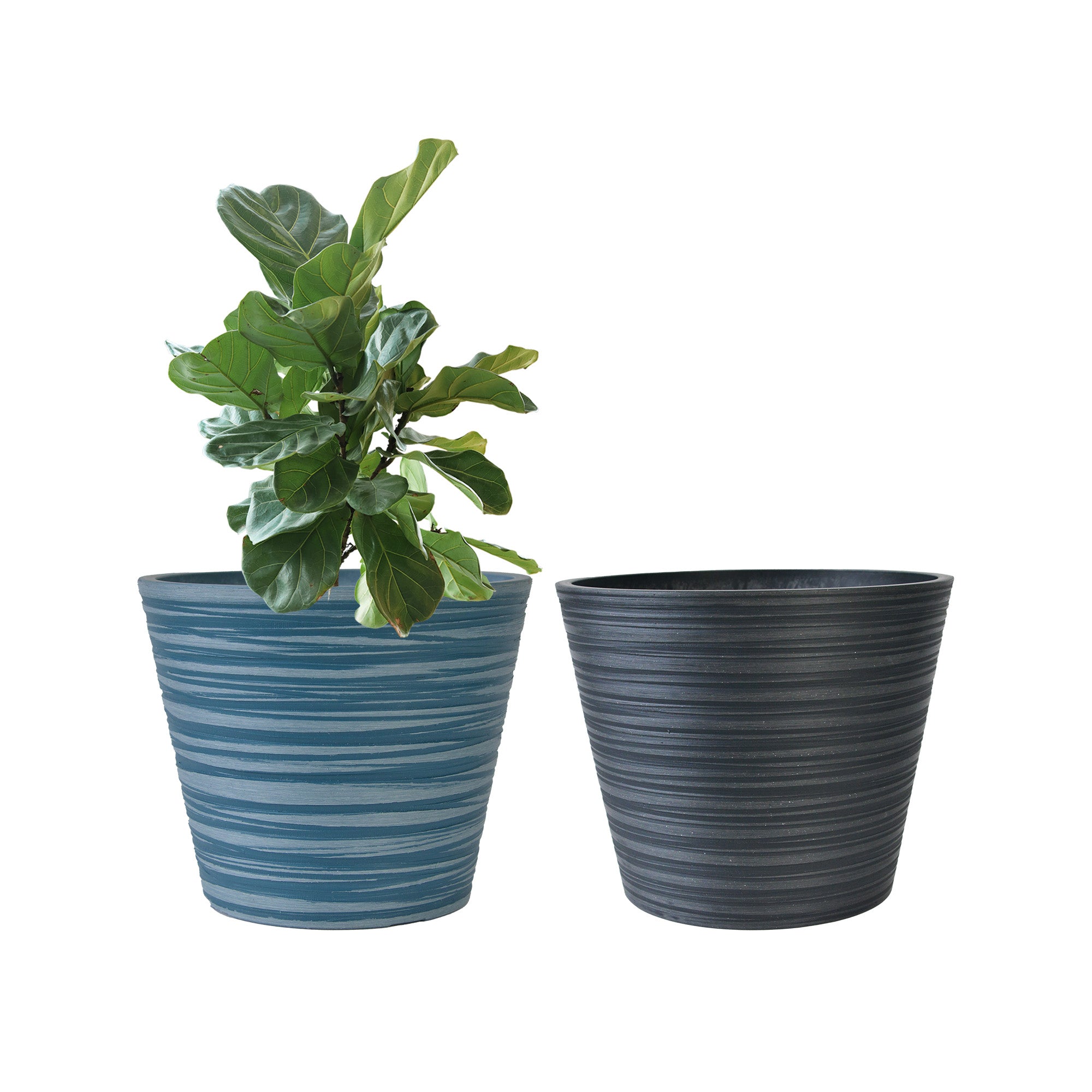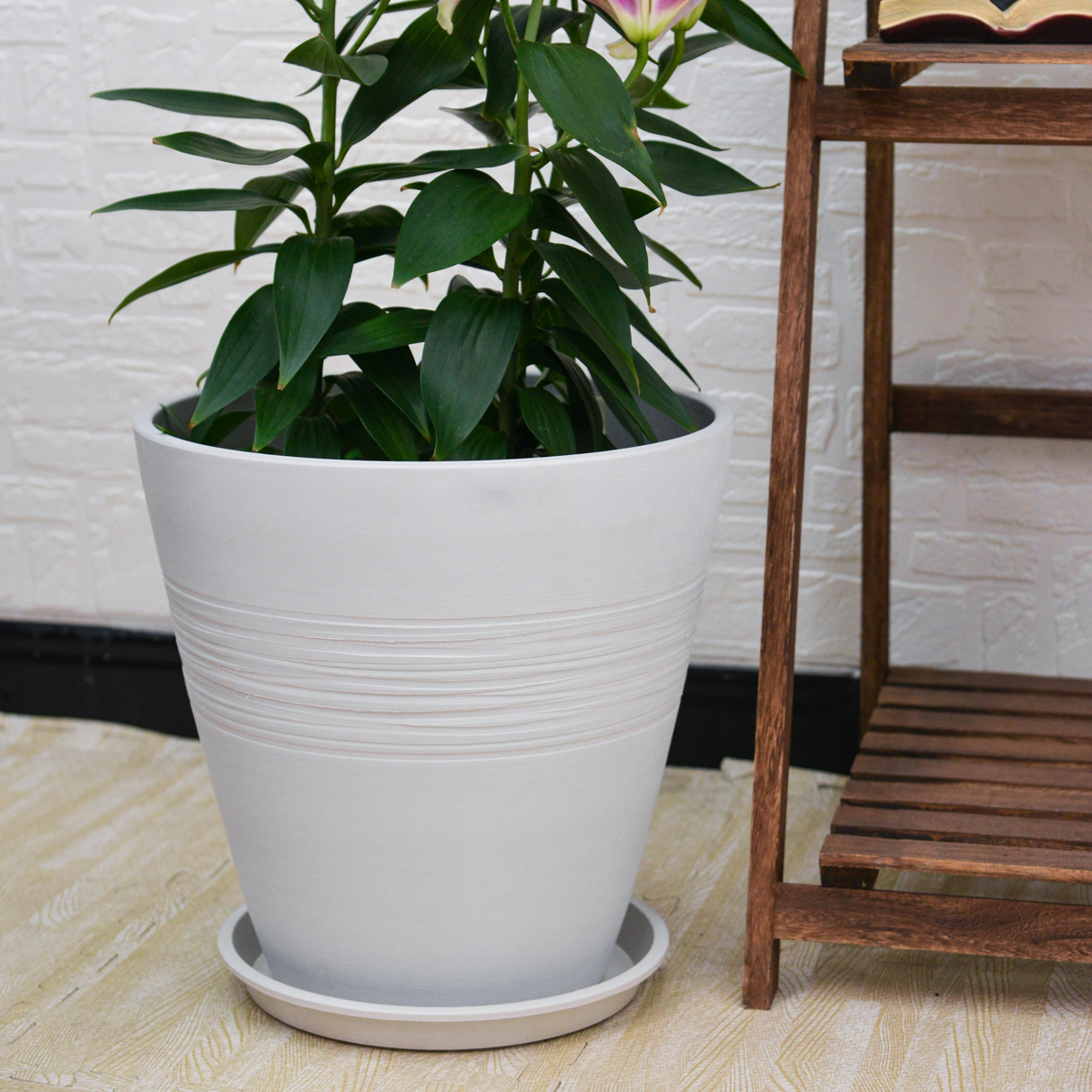Zinnias in Pots: The Ultimate Guide to Vibrant & Easy Container Gardening
Want to fill your sunny outdoor spaces with a riot of color and attract butterflies and hummingbirds? Zinnias are a perfect choice for vibrant and easy outdoor container gardening, celebrated for their dazzling blooms, wide array of colors and forms, and incredibly simple care. From dwarf zinnias perfect for small pots to taller varieties for bold displays, there’s a zinnia for every container and sunny spot. This comprehensive guide will provide you with everything you need to know to grow zinnias successfully in outdoor pots, from selecting the best varieties and containers to mastering essential care techniques for a season-long explosion of zinnia color.
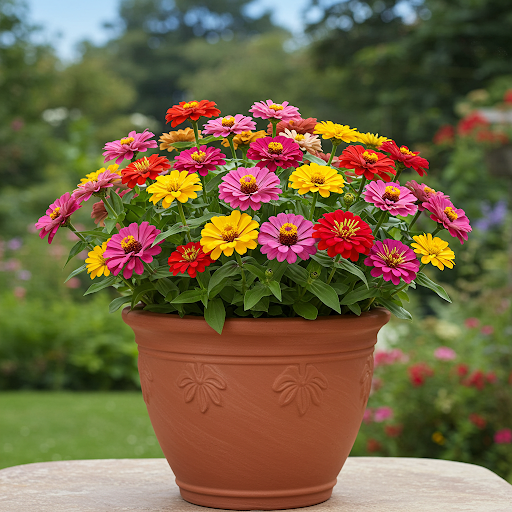
Zinnias
What are Zinnias (Zinnia)?
Zinnias (Zinnia) are a genus of flowering plants in the daisy family, Asteraceae, native to North and South America, but primarily Mexico. Zinnias are hugely popular annual bedding plants prized for their brilliant, long-lasting blooms and easy-to-grow nature. Zinnia flowers are typically daisy-like, dahlia-like, or cactus-flowered and come in an astonishing range of colors, including nearly every color except true blue and including shades of pink, purple, red, orange, yellow, white, green, and bi-colors. They are broadly categorized into types based on flower form and plant height, including Dwarf Zinnias, Medium Zinnias, and Tall Zinnias, as well as various flower types like single, double, semi-double, and crested. Zinnias are cherished for their long blooming season, vibrant and diverse colors, ability to attract pollinators (butterflies, bees, hummingbirds), and cut-flower suitability, making them a must-have for any sunny container garden or cutting garden.
Are Zinnias (Zinnia) Good for Outdoor Pots?
Yes, Zinnias (Zinnia) are exceptionally well-suited for outdoor pots and container gardening. Their upright, bushy, and dwarf growth habits make them ideal for filling pots, window boxes, and patio containers with brilliant color. Zinnias are sun-loving plants and bloom profusely throughout the summer and into fall, providing a long-lasting and spectacular display in containers. Their adaptability, wide variety of colors and forms, and ease of care make them a fantastic and rewarding choice for container gardens of all styles, especially for adding low-maintenance, high-impact color to sunny patios, balconies, and decks.
Ideal Growing Conditions for Zinnias (Zinnia) in Pots:
- Types of Zinnias for Pots: All types of zinnias can be grown in pots, but some are particularly well-suited for container displays due to their size and growth habit. Consider these vibrant zinnia types for your pots:
- Dwarf Zinnias: (e.g., ‘Profusion Series’, ‘Zinnia elegans ‘Thumbelina”, ‘Zinnia marylandica ‘Zahara Series”) – Compact and bushy, typically 6-12 inches tall, perfect for smaller pots, front of borders, and edging. Known for their compact habit, early and prolific blooming, and disease resistance. Excellent for mass plantings in containers, window boxes, and mixed arrangements.
- Medium Zinnias: (e.g., ‘Zinnia elegans ‘Benary’s Giant Series’ (when pinched), ‘Magellan Series’, ‘Dreamland Series’) – Reach 1-2 feet in height, offering a good mid-range size for containers. Versatile for medium to large pots, providing a fuller display than dwarf types. Can be used as “fillers” or “thrillers” in mixed containers depending on the variety. Pinching back young plants encourages bushier growth suitable for pots.
- Tall Zinnias: (e.g., ‘Zinnia elegans ‘Benary’s Giant Series’ (unpinched), ‘Zinnia elegans ‘Cut and Come Again”) – Can reach 2-4 feet tall, best suited for large containers as “thrillers” or focal points. Provide dramatic height and bold blooms. May require staking in pots, especially in windy locations. Excellent for cutting gardens in containers. Choose carefully for container size appropriateness.
- Cactus-Flowered Zinnias: (e.g., ‘Zinnia elegans ‘Cactus Flowered Mix”) – Unique flower form with quilled petals, adding textural interest to containers. Available in various heights, choose dwarf or medium types for pots.
- Dahlia-Flowered Zinnias: (e.g., ‘Zinnia elegans ‘Giant Dahlia Flowered Mix”) – Large, double flowers resembling dahlias, providing a classic and showy look in containers. Choose dwarf or medium types for pots.
- Light: Zinnias need full sun to thrive and bloom abundantly. They require at least 6-8 hours of direct sunlight per day to produce masses of flowers and maintain vibrant colors. Locations with morning sun and afternoon shade can also work, but full sun is optimal for maximum flowering. Insufficient light will result in fewer blooms, leggy growth, and less intense colors. Choose the sunniest spot for your zinnia containers.
- Soil: Zinnias prefer well-draining soil that is fertile and rich in organic matter. Use a high-quality potting mixspecifically formulated for containers or flowers. Amend potting mix with compost to improve fertility and drainage. Avoid overly heavy or poorly draining soils. A good potting mix will provide the necessary drainage, aeration, and nutrients for healthy zinnia growth and flowering in pots.
- Watering: Zinnias prefer consistent moisture, especially when grown in pots, but they do not like to be waterlogged and are somewhat drought-tolerant once established. Water thoroughly when the top inch of soil feels slightly dry. Water deeply until water drains out of the drainage holes. Allow the soil to slightly dry out between waterings. Avoid overwatering and soggy soil, which can lead to root rot and fungal diseases. Zinnias are more tolerant of slightly dry conditions than consistently wet soil. Water less frequently in cooler weather or shade. Check soil moisture regularly and adjust watering frequency based on weather conditions and pot size. Water at the base of the plant to keep foliage and flowers dry and help prevent fungal diseases like powdery mildew.
- Temperature: Zinnias are warm-weather annuals and thrive in warm temperatures. They perform best in temperatures between 65°F to 90°F (18°C to 32°C). They are sensitive to frost and cold temperatures. Plant zinnias outdoors after the last frost in your area, and when soil temperatures have warmed up. They thrive in heat and continue to bloom prolifically through hot summer weather.
- Fertilizer: Zinnias are moderate feeders and benefit from regular fertilization, especially when grown in pots where nutrients can leach out more quickly. Fertilize monthly or bi-monthly during the growing season to encourage continuous blooming. Use a balanced liquid fertilizer (e.g., 10-10-10 or 20-20-20) diluted to half strength, or a fertilizer specifically formulated for flowering annuals. Avoid high-nitrogen fertilizers, which can promote leafy growth at the expense of flowers. A balanced fertilizer will support both healthy foliage and abundant blooms.
Choosing the Right Pots for Zinnias (Zinnia):
- Suitable Pot Types: Zinnias are adaptable to various pot types, including terracotta, ceramic, plastic, resin, and metal containers. Consider these factors when selecting pot types for zinnias:
- Terracotta Pots: Porous, allow good aeration and drainage, and aesthetically pleasing, but dry out more quickly, requiring more frequent watering, especially in hot weather. Well-suited for zinnias, especially in hotter climates where good drainage is beneficial.
- Ceramic Pots: Available in many decorative styles, retain moisture better than terracotta, and can add a decorative element to your container garden. Ensure good drainage. Good for zinnias in general, and especially for maintaining consistent moisture in warmer weather.
- Plastic Pots: Lightweight, inexpensive, retain moisture well, available in various colors and styles. Choose good quality plastic pots that are durable and UV-resistant. Good for all zinnia types, especially for larger plantings and when moisture retention is desired.
- Resin Pots: Lightweight, durable, available in various styles mimicking terracotta or ceramic, and retain moisture well. A good alternative to heavy ceramic pots, and often offer better moisture retention than terracotta.
- Metal Containers: Can add a modern or rustic look, but can heat up quickly in full sun, potentially drying out soil faster. Ensure good drainage and consider lighter colors to reflect heat.
- Window Boxes & Long Planters: Excellent for mass plantings of dwarf and medium zinnias on windowsills, railings, or as porch planters. Choose boxes with good drainage and sufficient depth.
- Drainage: Excellent drainage is essential for zinnias to prevent root rot and fungal diseases. Ensure your chosen pot has drainage holes at the bottom. Avoid pots without drainage holes. Elevating pots slightly can improve drainage and air circulation around the base. Adding a layer of gravel or pot shards at the base of the pot is generally not necessary if using a well-draining potting mix, but can be done for extra precaution, especially in very heavy pots or mixes.
- Pot Size: Choose pot sizes appropriate for the type and mature size of the zinnia you are planting.
- Dwarf Zinnias: For dwarf zinnias, pots that are 6-8 inches in diameter are suitable for individual plants. For fuller displays or multiple plants, use pots that are 10-12 inches or larger, or window boxes.
- Medium Zinnias: Medium zinnias need slightly larger pots to accommodate their size and root systems. Use pots that are 8-12 inches in diameter for individual plants, and larger for mixed containers or to accommodate multiple plants.
- Tall Zinnias: Tall zinnias need the largest pots to support their height and prevent them from becoming top-heavy. Use pots that are 12 inches in diameter or larger for individual plants, and very large containers for multiple plants. Consider wider, more stable pots for tall varieties.
- Depth: Ensure pots are at least 6-8 inches deep for dwarf and medium zinnias, and 8-10 inches deep for tall zinnias to provide adequate root space and support.
- Color and Style: Choose pot colors and styles that complement your zinnia blooms and your outdoor décor. Brightly colored pots can enhance the already vibrant colors of zinnias, while neutral pots can provide a more sophisticated backdrop. Consider using contrasting pot colors to make zinnia blooms pop.
Essential Care Tips for Thriving Zinnias (Zinnia) in Outdoor Pots:
- Watering: “Water When Topsoil is Dry, Avoid Overwatering”. Water thoroughly when the top inch of soil feels dry. Allow the soil to slightly dry out between waterings. Avoid overwatering and soggy soil. Water less frequently in cool or cloudy weather.
- Sunlight: Provide Full Sun. Place zinnia pots in a location that receives at least 6-8 hours of direct sunlight daily.
- Fertilizing: Fertilize Lightly, Monthly or Bi-Monthly. Fertilize monthly or bi-monthly with a balanced liquid fertilizer or flowering plant fertilizer to encourage continuous blooming. Avoid over-fertilizing.
- Deadheading (Essential for Continuous Bloom): Deadhead spent or faded flowers regularly to encourage more blooms and keep plants looking tidy. Pinch or snip off dead flower heads right below the flower. Regular deadheading is crucial for prolific and continuous flowering in zinnias.
- Pinching Back (Promote Bushiness): Pinch back young zinnia seedlings when they are about 4-6 inches tall to encourage branching and bushier growth, resulting in more flowers. Pinch off the top inch or two of the main stem. Pinching is particularly beneficial for taller and medium zinnia types to make them more suitable for containers.
- Pest and Disease Control: Zinnias are generally relatively pest and disease-resistant, but monitor for common pests like spider mites, aphids, Japanese beetles, and snails/slugs. Powdery mildew is a common fungal disease, especially in humid conditions or with poor air circulation. Ensure good air circulation by spacing plants adequately, avoid overcrowding, water at the base of the plant, and treat any pest or disease issues promptly with insecticidal soap, horticultural oil, neem oil, or appropriate fungicides if necessary. Choose disease-resistant varieties to minimize powdery mildew problems.
- Staking (For Tall Varieties – Optional): Tall zinnia varieties may require staking in pots, especially in windy locations, to prevent stems from bending or breaking under the weight of the flowers. Use plant stakes or bamboo stakes to support tall stems as needed.
Popular Zinnia Cultivars for Pots (by Type):
- Dwarf Zinnias: ‘Profusion Series’, ‘Zahara Series’, ‘Thumbelina Mix’, ‘Magellan Series’ (dwarf types)
- Medium Zinnias: ‘Benary’s Giant Series’ (pinched), ‘Cut and Come Again’ (pinched), ‘Dreamland Series’, ‘Oklahoma Series’
- Tall Zinnias: ‘Benary’s Giant Series’ (unpinched), ‘California Giants Mix’, ‘State Fair Mix’, ‘Zinnia elegans ‘Purple Prince”
- Cactus-Flowered Zinnias: ‘Cactus Flowered Mix’, ‘Zinnia elegans ‘Giant Cactus Flowered Dahlia Mix’
- Dahlia-Flowered Zinnias: ‘Giant Dahlia Flowered Mix’, ‘Zinnia elegans ‘Benary’s Giant Dahlia Flowered Mix’
In Summary:
Growing Zinnias (Zinnia) in outdoor pots is a simple and incredibly rewarding way to add dazzling, long-lasting color and attract beneficial pollinators to your sunny outdoor spaces. Their easy-care nature, wide variety of colors and forms, and long blooming season make them a perfect choice for container gardeners of all levels. By providing full sun, well-draining potting mix in pots with drainage, watering appropriately and allowing the soil to slightly dry between waterings, fertilizing lightly, deadheading spent blooms, and pinching back young plants for bushiness, you can easily cultivate spectacular zinnia displays in pots and enjoy their vibrant beauty and garden benefits all season long.
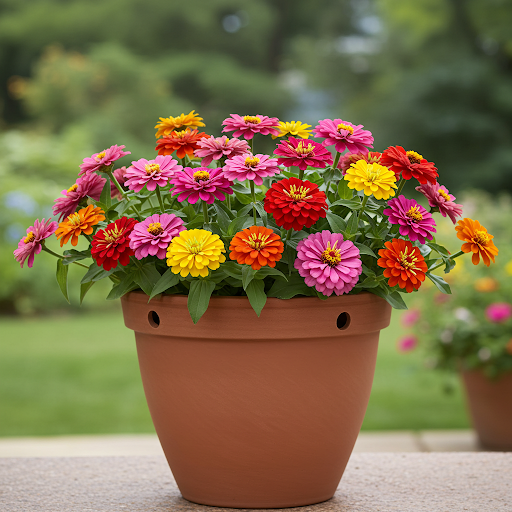
Zinnias
For more detailed botanical information and to explore the amazing diversity of Zinnia varieties, you can visit the Wikipedia page on Zinnia.
Important Note: Zinnias (Zinnia) are considered non-toxic to humans and pets, making them a safe and cheerful choice for households with children and animals. The primary care benefits of zinnias in pots include their ease of growth, vibrant color, and attractiveness to pollinators. With these simple care practices, you can enjoy a season filled with the dazzling beauty and garden benefits of zinnias in your outdoor containers.
Modern Plant Pots丨Planter for Indoor Plants,8 inch or 10 inch Plant Pots with Drainage Hole,Decorative Flower Pots
By greenship-seo|2025-04-10T08:32:55+00:00January 7, 2025|Categories: Hand-carving Series|Tags: Decorative Flower Pots, Self-Watering Pots|
k2-21G
By greenship|2024-08-13T06:17:26+00:00August 13, 2024|Categories: Hand-carving Series|
K2-11T
By greenship|2024-08-13T04:21:25+00:00August 13, 2024|Categories: Hand-carving Series|
11V
By greenship|2024-08-13T03:05:48+00:00August 13, 2024|Categories: Hand-carving Series|
Planter 5 in W / 8 in W / 12 in W or Indoor Outdoor Plants, Modern Decorative Plant Pots with Drainage Hole, Decorative Flower Pots
By greenship-seo|2025-04-10T06:37:58+00:00January 16, 2025|Categories: Hand-carving Series|Tags: Decorative Flower Pots|
KC2-GS
By greenship|2024-08-16T06:30:21+00:00August 16, 2024|Categories: Hand-carving Series|



